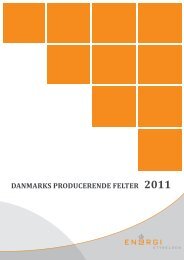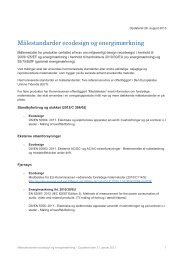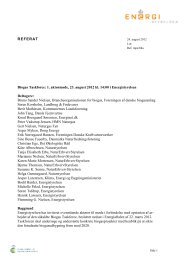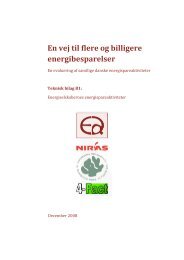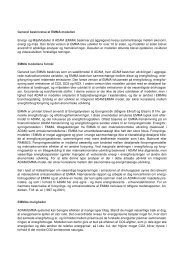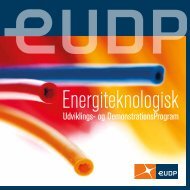Energy Strategy 2050 – from coal, oil and gas
Energy Strategy 2050 – from coal, oil and gas
Energy Strategy 2050 – from coal, oil and gas
Create successful ePaper yourself
Turn your PDF publications into a flip-book with our unique Google optimized e-Paper software.
On the way towards fossil fuel independence by <strong>2050</strong> <strong>–</strong> effects <strong>and</strong> benefits of the government’s initiatives<br />
Reduction of non-ETS emissions<br />
Efforts to reduce greenhouse <strong>gas</strong> emissions are required<br />
in the short term if Denmark is to meet its commitments<br />
for 2020, i.e. to reduce non-ETS emissions by 20%<br />
by 2020 in relation to 2005. In 2008, non-ETS emissions<br />
made up approximately 58% of Denmark’s total<br />
emissions <strong>and</strong> included greenhouse <strong>gas</strong> emissions<br />
As part of the EU climate <strong>and</strong> energy package of 2008, a<br />
common EU target for the non-ETS sectors was set for<br />
a reduction of approximately 10% by 2020 in relation to<br />
2005. The common target has been divided into national<br />
reduction commitments. Denmark has committed itself<br />
to reducing non-ETS emissions by 20% by 2020 in relation<br />
to 2005. Denmark’s reduction commitment is one<br />
of the highest in the EU. In comparison, other member<br />
states have reduction commitments that lie between<br />
-20% <strong>and</strong> +20%, see Figure 4.11.<br />
In contrast to the commitment period 2008-2012, where<br />
the emissions average throughout the period may not<br />
exceed the commitment target, commitments for the<br />
period 2013-2020 are annual commitment targets. This<br />
means that member states must meet a fixed reduction<br />
target every year. Reduction targets follow an ever<br />
increasing linear path with a fixed increase <strong>from</strong> the<br />
start in 2013 until the final target is reached in 2020. In<br />
Denmark’s case this corresponds to 20 % reduction in<br />
relation to 2005. Thus a reduction path is created made<br />
up of annual sub-targets. Member states may exceed<br />
their commitment targets in the first years, so as to ‘save<br />
up’ for years to come.<br />
Figure 4.11 Burden sharing of the EU reduction commitment<br />
in non-ETS sectors by 2020 relative to 2005<br />
Box 4.1 Target for 20% reduction in non-ETS emissions by<br />
2020<br />
52<br />
<strong>Energy</strong> <strong>Strategy</strong> <strong>2050</strong> <strong>–</strong> <strong>from</strong> <strong>coal</strong>, <strong>oil</strong> <strong>and</strong> <strong>gas</strong> to green energy.<br />
<strong>from</strong> transport, agriculture, households, waste <strong>and</strong> less<br />
significant parts of industry <strong>and</strong> the energy sector, e.g.<br />
small-scale CHP plants. ETS emissions primarily stem<br />
<strong>from</strong> electricity <strong>and</strong> heat production as well as energyintensive<br />
companies, <strong>and</strong> are regulated by the EU Emissions<br />
Trading Scheme.<br />
Portugal<br />
Slovenia<br />
Malta<br />
Czech Republic<br />
Hungary<br />
Estonia<br />
Slovakia<br />
Pol<strong>and</strong><br />
Lithuania<br />
Latvia<br />
Romania<br />
Bulgaria<br />
Denmark<br />
Irel<strong>and</strong><br />
Luxembourg<br />
Sweden<br />
Netherl<strong>and</strong>s<br />
Austria<br />
Finl<strong>and</strong><br />
United Kingdom<br />
Belgium<br />
Germany<br />
France<br />
Italy<br />
Spain<br />
Cyprus<br />
Greece<br />
-20 -15 -10 -5 0 5 10 15 20




